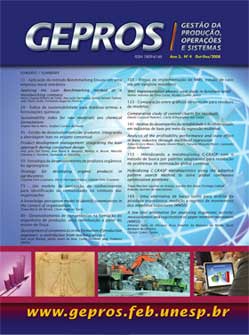Comparative study of control charts for residuals
DOI:
https://doi.org/10.15675/gepros.v4i4.508Abstract
Control charts (CCs) are among the most popular statistical tools for process monitoring in industry. When implementing CCs in practice, it is necessary to validate two basic assumptions: (i) data samples collected from the process are independent and (ii) identically distributed. If the data sampled are autocorrelated, the first assumption is violated and the control chart will yield a large number of false alarms. When the variable is dependent on process parameters, and these parameters vary during process execution, the reference model for the process is not the same for all data samples emerging from the process. In the first case, the usual approach is to monitor the residuals from a time series model adjusted to process data. For the second case, a regression model relating the dependent variable to process parameter is adjusted, followed by a control chart for the residuals. The present paper thus aims to compare the performance of these approaches in a same data sample. A flowchart is introduced to orient the application of these control charts. Key words: Control Charts; Residuals; Regression; ARIMA.Downloads
Published
How to Cite
Issue
Section
License
O(s) autor(es) do artigo autorizam a publicação do texto na revista e garantem que a contribuição é original e inédita, não estando em processo de avaliação em outra(s) revista(s). As opiniões, ideias e conceitos emitidos nos textos são de inteira responsabilidade do(s) autor(es), não sendo a revista responsável por tais conteúdos.
Os editores da revista reservam o direito de efetuar ajustes textuais e de adequação às normas da publicação, caso necessário.
Os autores mantêm os direitos autorais sobre o trabalho e concedem à revista o direito de primeira publicação, sendo o trabalho simultaneamente licenciado sob a Attribution 4.0 International (CC BY 4.0), o que permite o compartilhamento do trabalho com reconhecimento da autoria e publicação inicial nesta revista.
Os autores têm autorização para firmar contratos adicionais, separadamente, para distribuição não-exclusiva da versão do trabalho publicada nesta revista (ex.: publicar em repositório institucional ou como capítulo de livro), com reconhecimento de autoria e publicação inicial nesta revista.












